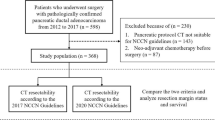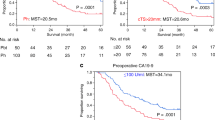Abstract
Background
This study aimed to identify that Yonsei criteria (YC) can be regarded as a preoperative clinical parameter to predict biological behavior of the left-sided pancreatic cancer.
Methods
Between June 2007 and December 2014, 135 patients who underwent minimally invasive (MIS) or open distal pancreatectomy for left-sided pancreatic cancer were enrolled in this study consecutively. Perioperative short-term and long-term oncologic outcomes were analyzed according to the YC retrospectively.
Results
Fifty-four and 81 patients did and did not meet the YC, respectively. Short-term oncologic outcomes were favorable among those meeting the YC even after propensity score matching. Patients within the YC also had better disease-free and disease-specific overall survival (p < 0.05). In analysis for receiver operating characteristic curve, area under curve of CA19-9 was satisfactory only within YC group. Multivariate analysis for disease-free survival identified the YC as a strong independent prognostic factor (p < 0.05). In preoperative clinical setting, patients’ survival was clearly different based on following clinical groups, such as within YC, beyond YC, and unresectable.
Conclusions
Preoperative CT-based determined YC can predict excellent short-term and long-term oncologic outcomes. YC might have a potential role as a preoperative clinical staging for left-sided pancreatic cancer. External validations of YC based on multicenter cohorts are mandatory to confirm this oncologic significance of YC.





Similar content being viewed by others
References
Siegel RL, Miller KD, Jemal A (2015) Cancer statistics, 2015. CA Cancer J Clin 65(1):5–29
Krejs GJ (2010) Pancreatic cancer: epidemiology and risk factors. Dig Dis 28(2):355–358
Bonenkamp J (ed) (2004) Surgery for upper gastrointestinal malignancies. Seminars in oncology. Elsevier, Amsterdam
Appel BL, Tolat P, Evans DB, Tsai S (2012) Current staging systems for pancreatic cancer. Cancer J 18(6):539–549
Hüser N, Assfalg V, Reim D et al (2014) Pancreatic cancer—current status of multimodal management. Pancreas-ECAB 45
Choi SH, Kang CM, Hwang HK, Lee WJ, Chi HS (2012) Robotic anterior RAMPS in well-selected left-sided pancreatic cancer. J Gastrointest Surg 16(4):868–869
Choi SH, Kang CM, Lee WJ, Chi HS (2011) Laparoscopic modified anterior RAMPS in well-selected left-sided pancreatic cancer: technical feasibility and interim results. Surg Endosc 25(7):2360–2361
Han DH, Kang CM, Lee WJ, Chi HS (2014) A 5-year survivor without recurrence following robotic anterior radical antegrade modular pancreatosplenectomy for a well-selected left-sided pancreatic cancer. Yonsei Med J 55(1):276–279
Kang CM, Kim DH, Lee WJ (2010) Ten years of experience with resection of left-sided pancreatic ductal adenocarcinoma: evolution and initial experience to a laparoscopic approach. Surg Endosc 24(7):1533–1541
Lee SH, Kang CM, Hwang HK, Choi SH, Lee WJ, Chi HS (2014) Minimally invasive RAMPS in well-selected left-sided pancreatic cancer within Yonsei criteria: long-term (>median 3 years) oncologic outcomes. Surg Endosc 28(10):2848–2855
Kang CM, Lee SH, Lee WJ (2014) Minimally invasive radical pancreatectomy for left-sided pancreatic cancer: current status and future perspectives. World J Gastroenterol 20(9):2343–2351
Heinemann V, Haas M, Boeck S (2013) Neoadjuvant treatment of borderline resectable and non-resectable pancreatic cancer. Ann Oncol 24(10):2484–2492. doi:10.1093/annonc/mdt239
Katz MH, Fleming JB, Bhosale P, Varadhachary G, Lee JE, Wolff R et al (2012) Response of borderline resectable pancreatic cancer to neoadjuvant therapy is not reflected by radiographic indicators. Cancer 118(23):5749–5756
Kang CM, Chung YE, Park JY, Sung JS, Hwang HK, Choi HJ et al (2012) Potential contribution of preoperative neoadjuvant concurrent chemoradiation therapy on margin-negative resection in borderline resectable pancreatic cancer. J Gastrointest Surg 16(3):509–517
Kang CM, Hwang HK, Choi SH, Lee WJ (2013) Controversial issues of neoadjuvant treatment in borderline resectable pancreatic cancer. Surg Oncol 22(2):123–131
Bailey P, Chang DK, Nones K et al (2016) Genomic analyses identify molecular subtypes of pancreatic cancer. Nature 531:47–52. doi:10.1038/nature16965
Paulson AS, Cao HST, Tempero MA, Lowy AM (2013) Therapeutic advances in pancreatic cancer. Gastroenterology 144(6):1316–1326
Salem AI, Alfi M, Winslow E, Cho CS, Weber SM (2015) Has survival following pancreaticoduodenectomy for pancreas adenocarcinoma improved over time? J Surg Oncol 112(6):643–649
Kim CB, Ahmed S, Hsueh EC (2011) Current surgical management of pancreatic cancer. J Gastrointest Oncol 2(3):126
Costello E, Greenhalf W, Neoptolemos JP (2012) New biomarkers and targets in pancreatic cancer and their application to treatment. Nat Rev Gastroenterol Hepatol 9(8):435–444
Cen P, Ni X, Yang J, Graham DY, Li M (2012) Circulating tumor cells in the diagnosis and management of pancreatic cancer. Biochim Biophys Acta Rev Cancer 2(1826):350–360
Hurton S, Hayden JA, Molinari M (2015) Adjuvant therapy for resected pancreatic cancer. The Cochrane Library, Hoboken
Merkow RP, Bilimoria KY, Tomlinson JS, Paruch JL, Fleming JB, Talamonti MS et al (2014) Postoperative complications reduce adjuvant chemotherapy use in resectable pancreatic cancer. Ann Surg 260(2):372–377
Chan E, Berlin J (2014) Timing versus duration of adjuvant therapy for pancreatic cancer: all the lessons we need in life are taught to us as children. J Clin Oncol 32(6):487–488
Acknowledgement
Parts of this manuscript were presented in the Hepatobiliary Oncology Session at the GAP 2015 Conference, April 14–15, 2016, at the MD Anderson Cancer Center, Houston, TX, USA under the title “Yonsei Criteria in Minimally Invasive Surgery for Left-sided Pancreatic Cancer.”
Author information
Authors and Affiliations
Corresponding author
Ethics declarations
Disclosures
Drs. Sung Hwan Lee, Ho Kyoung Hwang, Chang Moo Kang and Woo Jung Lee have no conflicts of interest or financial ties to disclose.
Electronic supplementary material
Below is the link to the electronic supplementary material.
Supplementary Fig. 1
Distributions of propensity score before and after matching. (TIFF 902 kb)
Supplementary Fig. 2
Survival analysis for detailed population. Kaplan–Meier plots show disease-free survivals for pathologic T3 group (a) and practically detectable early pancreatic cancer in terms of node negative and well differentiated histology, and within YC (b). (TIFF 578 kb)
Rights and permissions
About this article
Cite this article
Lee, S.H., Hwang, H.K., Kang, C.M. et al. The Yonsei criteria as a clinically detectable parameter for excellent prognosis in resected left-sided pancreatic cancer: outcomes of a propensity score-matched analysis. Surg Endosc 31, 4656–4664 (2017). https://doi.org/10.1007/s00464-017-5529-6
Received:
Accepted:
Published:
Issue Date:
DOI: https://doi.org/10.1007/s00464-017-5529-6




